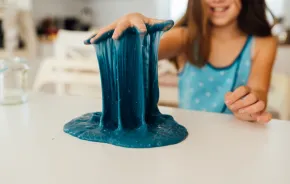Can toys inspire the next generation of female technology innovators?
That's what Alice Brooks and Bettina Chen, two engineers trained at M.I.T. and Stanford, believe. Brooks and Chen are the founders of Roominate, a company whose products, wired dollhouse building kits, are designed to spark young girls' interest in STEM (science, technology, engineering, math) through creative play.
I recently had the privilege of chatting with Roominate CEO and co-founder Alice Brooks about the roots of her interest in engineering, her favorite playthings as a kid, and what drove her to co-found Roominate, which prototyped, tested and launched its product line last year.

Why did you found Roominate?
Bettina and I met in grad school at Stanford. We became friends right away and started talking about why there weren’t more female engineers. We realized things we had done when we were younger planted that seed of loving engineering. When I was 8 years old I asked my dad if Santa Claus could bring me a Barbie and I got a saw instead. We were both playing with things that weren’t really traditional girls’ toys. The hypothesis we had was that if we could design something that could bring similar experiences to more girls then we’d be able to inspire more girls to think about engineering or other fields. We knew a lot of girls were already comfortable with dollhouses but we also saw that these dollhouses were so static. So [we thought] if we gave them the tools and circuits of building, they could actually design cooler things and have a lot more fun with it.
Tell me about reinventing the traditional dollhouse.
We really wanted [the girls] to do the whole process … to be able to make and design their own unique structure. So it’s not four rooms and they’re just going to arrange the furniture inside. And then we really wanted to give them that moment where they hook up a circuit. A lot of them have never put a battery in anything. So being able to put the batteries in and wire up the fan that moves – that’s a really exciting moment. One of the moments that can spark interest and that wanting more. We give them a lot of pieces and examples of things you can make but don’t ever say here are 200 steps of how to make this exact creation. You learn a lot more if you’re trying to figure out a problem and coming up against a couple roadblocks but eventually figure it out – that’s the really rich experience.
So you told me about asking for a Barbie and getting a saw instead. Can you think of other play experiences and toys you had growing up that got you interested in what you do today?
I have a dinosaur that I made, actually. My mom found it recently and it was sitting on my shelf when I was home last. I made that at around the same time. I was a little bit more advanced by that point because it looks like I sawed out part of a wooden dowel that I used for the tail so it would fit in nicely. It was nails and wood scraps. And then I also used watercolors on that one.
My mom let me have Barbies and I remember I would ask her for [extra clothes] and she’d say, “No. If you don’t have it, make it.” The easiest Barbie dress I figured out was you take a sock and cut three holes in it. I had so many tube-sock Barbie dresses. But just figuring out how to use those other things, pulling in those other tools like socks or whatever it was, that’s important in the engineering thought process. Using things in a different way – not exactly what they’re intended for – to help you build a better solution.
What other things do you think your parents did that helped encourage and support and lead you to where you are now?
My mom is a math teacher and she made it a game to do math. She’d give me math problems while I was brushing my teeth [laughing]. Also my dad is a roboticist so when I had to stay home sick from school I would go to his work. If he was busy he would just leave me with his grad students and I could wander around the robot lab. I remember [the grad students] telling me what a google was, one and a million zeroes or something, and I was trying to write it out on the whiteboard.
Can you pinpoint when and how you knew you wanted to go into engineering?
When I was younger I used to tell my parents, “I’m not going to do robotics and I’m not going to do math,” 'cause that’s what they did. So when I got to M.I.T. I remember looking at the majors and being like, “Well of course I’m going to do mechanical engineering. I love making stuff. And I’m going to be able to make so much cooler stuff if I do engineering than what I can already make.” I don’t know if there was ever a moment when I was younger where I said, “I’m going to be an engineer.” I don’t even think I knew what an engineer did. But all my childhood I always had a lot of fun making things and it just seemed like a natural decision when I got to school.
What barriers do you feel like you’ve faced along the way?
I think that for little kids there’s a lot of social pressure if you are interested in things like math and science. There’s a lot of being seen as the “nerdy” kid. Then at MIT, even though they have done a really good job of recruiting more women, there’s still this undercurrent of bias against females in sciences and engineering. One time someone asked what major I was and literally went through 10 other majors before I just told him. That was a moment that stuck out in my mind; that it would be so hard to grasp that I would be a mechanical engineer. And the first day [at Stanford] they told us our program for mechanical engineering was only 17 percent female. The whole room groaned. Being there you get questioned even more. “Well why did you decide to do this? Why are you here?”
And the response to Roominate has been overwhelmingly good?
It’s been amazing. From the beginning parents [said] they were so excited to finally see their daughters engaging in this way, really building and being creative. Figuring out how to balance something by putting a counterweight on the back, getting the [fan] motor going then having to figure out how to actually mount it in their house so it doesn’t fall over. And we get all these amazing pictures from [the girls]. They make things that we don’t even think of. One girl had the kit for a couple days and she made the Golden Gate Bridge. It took me a half hour to build what she built. They’ll just come up with all these new things. It’s the coolest part of it. It really is.

More about Roominate
Roominate offers three basic building kits: Basic Roominate, $29.99; Deluxe Roominate, $49.99; Roominate Dreamhouse Architect, $199, and other add-on sets. Visit the website to shop and learn more.
Also check out its active Facebook page
 About the author: Sharon Chang lives in South Seattle, WA. She is among many things an early educator, graduate student in Human Development, researcher/writer, and blogger at Multiracial Asian Families and Racism Review. But most importantly she is “mommy,” “mom,” and sometimes “mama” to an exhausting and totally awesome 3-year-old.
About the author: Sharon Chang lives in South Seattle, WA. She is among many things an early educator, graduate student in Human Development, researcher/writer, and blogger at Multiracial Asian Families and Racism Review. But most importantly she is “mommy,” “mom,” and sometimes “mama” to an exhausting and totally awesome 3-year-old.













